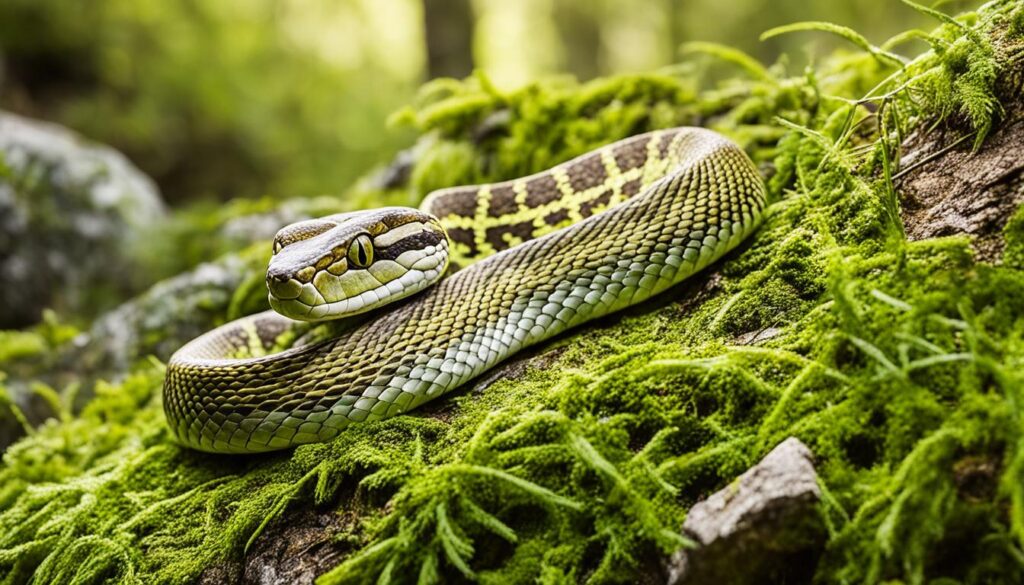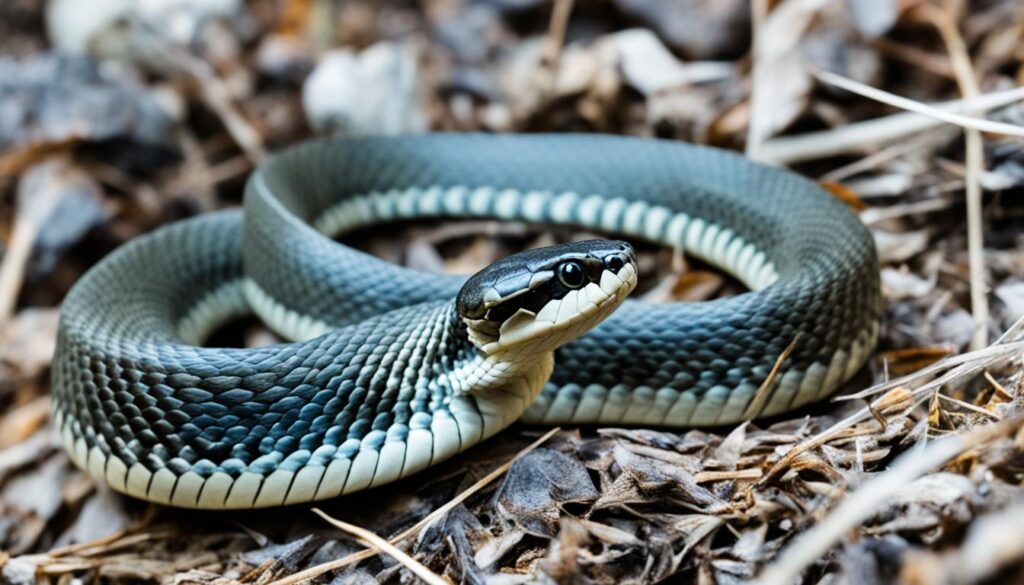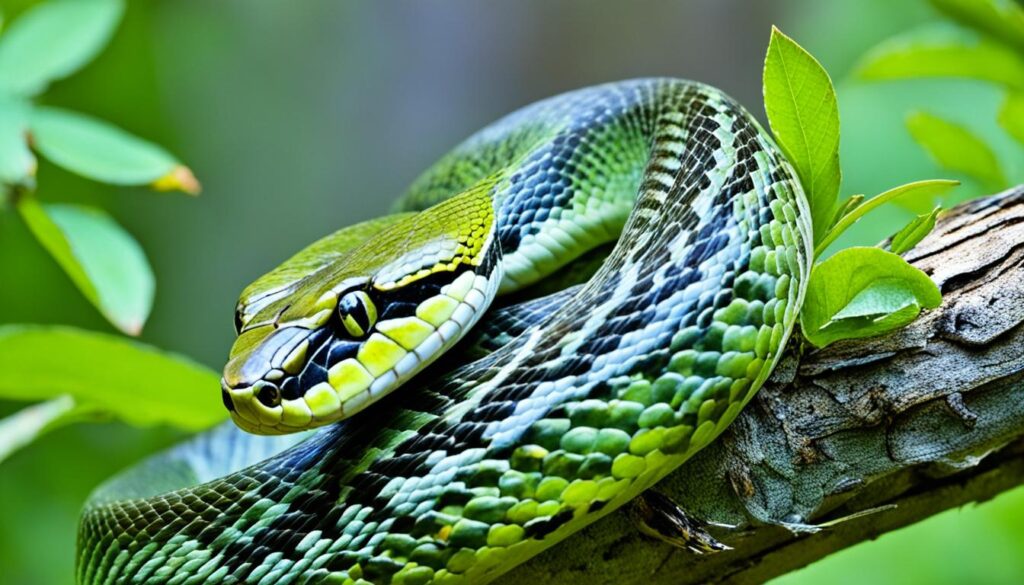Welcome to our article exploring one of Austria’s most intriguing questions: Are there snakes in Austria? You may be surprised to learn that despite its stunning Alpine landscapes and diverse wildlife, Austria is indeed home to a significant snake population.
Yes, Austria is home to a significant population of snakes, which thrive in its diverse landscapes, including Alpine meadows, forests, grasslands, wetlands, and rocky areas. The common European adder and the Nose-horned Viper are the only two venomous snake found in Austria.
By the end of this article, you will have gained a greater understanding of Austria’s snake population and how to coexist with these fascinating creatures. So let’s embark on this journey and unlock the mysteries of snakes in Austria!
Key Takeaways:
- Austria is home to a significant population of snakes.
- The country’s diverse landscapes provide a range of habitats for different snake species.
- Identifying and understanding snake safety is crucial for coexisting with snakes.
- Snakes play a vital role in controlling pests and maintaining ecological balance.
- Conservation efforts are in place to protect snake populations and their habitats in Austria.
Understanding Austria’s Climate and Habitat
Austria’s climate varies from region to region, offering a diverse range of habitats for various species, including snakes.
The country’s geographic diversity, with the majestic Alps in the west and the flat Danube Basin in the east, contributes to the availability of suitable habitats for snakes.
The Geographic Diversity of Austria
The Alpine landscapes in western Austria are characterized by high mountains, deep valleys, and alpine meadows.
These areas provide ideal habitats for many snake species. The eastern part of the country consists of lowlands, rolling hills, and the expansive Danube Basin, which offers its distinct range of habitats for snakes.
Habitats Suited for Snakes
Snakes in Austria can be found in various habitats, each with its unique characteristics and resources.
Some of these habitats include:
- Alpine meadows: These grassy areas in the mountains provide ample vegetation cover and prey opportunities for snakes.
. - Forests: Austria’s extensive forests offer shelter, food sources, and suitable microclimates for snakes to thrive.
. - Grasslands: Open grassy areas are favorable environments for snakes, providing hunting grounds and warmth.
. - Wetlands: Marshes, swamps, and wetlands provide rich biodiversity, attracting a variety of prey species for snakes.
. - Rocky areas: Snakes can inhabit rocky outcrops, cliffs, and slopes, using crevices and gaps for shelter.
Understanding the climate and habitats of Austria is essential to grasp the distribution and abundance of snakes in the country.
With such geographic diversity, Austria offers a range of environments that support different snake species, each adapted to thrive in its specific habitat.
Types of Snakes Found in Austria

Austria is home to several species of snakes. Some are native to the country, while others are considered invasive.
Native snake species in Austria include the smooth snake, European adder, grass snake, Aesculapian snake, dice snake, barred grass snake, and nose-horned viper.
These species have distinct characteristics and can be found in different habitats across the country.
Native Snake Species
The smooth snake (Coronella austriaca) is a non-venomous snake commonly found in Austria. It has a slender body and distinctive smooth scales.
Another native snake species in Austria is the European adder (Vipera berus), which is venomous and recognizable by its zigzag pattern on the back and V-shaped markings on the head.
The grass snake (Natrix natrix), on the other hand, is a non-venomous species with a greenish color and yellow collar around the neck.
The Aesculapian snake (Zamenis longissimus) is a large non-venomous snake found in Austria. It has a brownish color and is known for its arboreal habits.
The dice snake (Natrix tessellata) is another non-venomous snake species with a distinctive pattern of dark spots on its back.
The barred grass snake (Natrix helvetica) is a closely related species to the grass snake but has a more barred pattern on its body.
The nose-horned viper (Vipera ammodytes) is a venomous snake species found in certain regions of Austria.
It has a triangular-shaped head and a characteristic “horn” on its nose, which gives it its name. The nose-horned viper is a rare and protected species in Austria due to its declining population.
Commonly Encountered Snakes
Among the commonly encountered snake species in Austria, the European adder is the most widespread.
It can be found in a variety of habitats, including forests, meadows, and alpine regions.
The grass snake is often seen near water bodies such as ponds, lakes, and rivers, as it is an excellent swimmer and feeds on amphibians and fish.
The smooth snake prefers dry grasslands and heathlands, where it hunts small reptiles and rodents.
Rare and Protected Snake Species
Several snake species in Austria are classified as rare and protected due to their declining populations.
The nose-horned viper is one such species, as mentioned earlier. Other protected snake species include the dice snake and the barred grass snake.
Conservation efforts are in place to safeguard these species and their habitats, ensuring their survival for future generations.
Identifying Snakes in Austria

Identifying snakes in Austria can be an exciting and educational experience. Each species has unique physical characteristics that help in their identification.
These include size, coloration, patterns, and markings. Understanding these characteristics is important for accurately identifying snakes in Austria.
Physical Characteristics of Austrian Snakes
Austrian snakes exhibit a diverse range of physical characteristics that aid in their identification. Some key features to look out for include:
- Size: Snakes in Austria vary in size, from small and slender to larger and more robust specimens. Pay attention to their length and overall body structure.
. - Coloration: Snakes in Austria can have different coloration, ranging from vibrant greens and browns to more muted earth tones. Some species may even have distinct patterns or bands.
. - Patterns and Markings: Keep an eye out for patterns and markings on the snakes’ bodies. These can include zigzag lines, spots, or stripes, which are characteristic of particular species.
Where and When to Spot Snakes
Knowing where and when to spot snakes is essential for increasing the chances of observing them in their natural habitats.
Snakes can be found in various locations throughout Austria, including:
- Forests and woodlands, where they may seek shelter under rocks, fallen leaves, or logs.
- Meadows and grasslands, where they can blend in with their surroundings.
- Wetlands and marshes, where they may be attracted to water sources.
- Rocky areas and hillsides, where they can find suitable hiding spots.
Snakes are ectothermic, meaning their activity levels depend on external temperatures.
To increase your chances of spotting snakes, the best time is during their active season, which typically occurs from spring to early autumn when temperatures are warmer.
Snakes are more likely to be active during the daylight hours, particularly when the weather is sunny and favorable.
With a keen eye for physical characteristics and knowledge of the right habitats and seasons, you’ll be well-equipped to identify and spot snakes in Austria.
Remember to always observe snakes from a safe distance and respect their natural habitats to ensure a harmonious coexistence with these remarkable creatures.
Snake Safety and First Aid

While snakes are generally non-aggressive and will avoid humans if given the chance, it’s crucial to be aware of snake safety and know how to respond in case of snake encounters.
How to Avoid Snake Encounters
Prevention is key when it comes to snake safety. Here are some tips to help you avoid snake encounters:
How To Avoid Snake Encounters:
- ✅ Stay on designated paths and avoid walking through tall grass or dense vegetation where snakes may be hiding.
- ✅ Wear appropriate footwear, such as sturdy closed-toe shoes or boots, to protect your feet from potential snake bites.
- ✅ Be cautious when lifting rocks, logs, or other objects in nature, as they may be hiding spots for snakes.
- ✅ Avoid reaching into areas where you cannot see, as there may be hidden snakes.
By following these simple guidelines, you can reduce the risk of snake encounters and ensure your safety in snake habitats.
First Aid for Snake Bites
While snake bites are relatively rare, it’s important to know how to respond in case of a venomous snake bite. Here are the steps to take:
- Stay calm and call for medical help immediately. Time is of the essence in treating snake bites.
. - Keep the affected area below heart level to slow the spread of venom.
. - Remove any tight clothing or jewelry near the bite site, as swelling may occur.
. - Do not apply a tourniquet or attempt to suck out the venom. These methods can cause more harm than good.
. - Clean the wound with soap and water if available, but do not flush it with water or use ice.
. - Keep the bitten person still and calm to slow down the spread of venom through the bloodstream.
Remember, seeking immediate medical attention is vital in treating snake bites and minimizing potential complications.
Understanding Venomous Snakes in Austria
While Austria is home to several snake species, only a few are venomous. The venomous snakes found in Austria include the nose-horned viper (Vipera ammodytes) and the adder (Vipera berus).
These snakes have specialized venom glands and can deliver venomous bites. It’s important to be able to identify these snakes to minimize the risk of venomous snake bites.
By familiarizing yourself with the characteristics and behaviors of venomous snakes in Austria, you can further enhance your snake safety knowledge and respond appropriately in their presence.
The Role of Snakes in Austrian Ecosystems

Snakes play a crucial role in Austrian ecosystems, contributing to the balance and health of the environment.
They serve as both predators and prey, impacting various organisms within the ecosystem.
Snakes as Predators and Prey
As predators, snakes play an essential role in controlling the populations of rodents, amphibians, and insects.
They help maintain ecological balance by keeping these populations in check, preventing them from reaching excessive numbers that could have detrimental effects on the ecosystem.
Snakes use their unique hunting abilities and adaptability to target and consume these smaller organisms, making them a vital component of the food chain.
Additionally, snakes serve as prey for larger predators within the Austrian ecosystems. They play a crucial role in providing a food source for animals such as birds of prey, foxes, and other carnivorous species.
By being part of the predator-prey relationship, snakes contribute to the overall biodiversity and functioning of the ecosystem, helping to maintain a healthy and thriving natural environment.
The Importance of Snakes in Controlling Pests
One of the significant contributions of snakes to Austrian ecosystems is their role in pest control.
Snakes are natural predators of rodents, such as mice and rats, which can cause extensive damage to crops, spread diseases, and disrupt the balance of local fauna.
By preying on these pests, snakes help keep their populations in check, reducing the negative impact on agricultural systems and maintaining a sustainable environment.
Furthermore, snakes also consume various insects and amphibians, further contributing to pest control in their respective habitats.
Insects, such as mosquitoes and grasshoppers, can cause agricultural damage and have implications for human health.
By controlling their populations, snakes help minimize the negative impacts of these pests on crops and the wider ecosystem.
The role of snakes in pest control is especially relevant in agricultural areas, where the preservation of crops and the reduction of pesticide usage are significant concerns.
By recognizing and valuing the ecosystem services provided by snakes, we can adopt more sustainable practices that promote coexistence and the preservation of these important creatures.
Understanding the ecological significance of snakes in Austrian ecosystems is crucial for appreciating their presence and contribution to the environment.
By maintaining a balanced predator-prey relationship and controlling pest populations, snakes play a vital role in preserving the biodiversity and overall health of Austrian ecosystems.
Legal Protection and Conservation Efforts

Snakes in Austria are protected by various laws and regulations to ensure their conservation and preservation.
These legal measures are crucial in safeguarding the diverse snake population found in the country’s habitats.
Laws Protecting Snakes in Austria
The Austrian government has implemented laws that prohibit the hunting, killing, capturing, and trading of snakes.
These protective measures aim to prevent the decline of snake populations and preserve their habitats.
By strictly enforcing these laws, authorities are working to maintain a sustainable and balanced ecosystem.
Conservation Programs and Initiatives
In addition to legal protection, snake conservation programs and initiatives play a vital role in preserving Austria’s snake species.
These programs focus on raising awareness about the importance of snakes in the ecosystem, conducting research to understand their behavior and habitat requirements, and implementing measures to protect their natural habitats.
Conservation organizations in Austria collaborate with experts, scientists, and local communities to develop strategies that promote the coexistence of snakes and humans.
They also work towards educating the public about the benefits of snake conservation and the significance of maintaining biodiversity in the country.
Conclusion
In conclusion, Austria is home to a diverse snake population that enriches the country’s wildlife and ecosystems.
By understanding the climate, habitats, and different snake species in Austria, we can foster a harmonious coexistence with these fascinating creatures while appreciating and conserving Austria’s natural heritage.
It is crucial to prioritize snake safety to ensure our well-being and the well-being of snakes.
If you encounter a snake, remember to maintain a respectful distance and avoid disturbing or provoking it.
By respecting their space, we can reduce the chances of unwanted interactions. In the event of a snake bite, seeking immediate medical attention is essential.
Remember, trained professionals are equipped to provide the necessary care and treatment.
To ensure the long-term survival of snakes in Austria, supporting conservation efforts is vital.
These initiatives focus on raising awareness about the importance of snake conservation, conducting research to better understand and protect snake habitats, and implementing measures to preserve their populations.
By supporting these conservation programs, we can contribute to the preservation of Austria’s natural heritage and maintain the delicate balance of its ecosystems.
By embracing our role as stewards of the environment, we can coexist with snakes and appreciate the unique role they play in maintaining the ecological balance.
Together, let us protect and conserve Austria’s snake population, preserving their place in the rich tapestry of the country’s natural heritage for generations to come.
Frequently Asked Questions
Q: Are snakes common in Austria?
A: Yes, snakes are relatively common in Austria, especially in rural and forested areas, but they are less frequently encountered in urban areas.
Q: Are there pythons in Austria?
A: No, pythons are not native to Austria. They are tropical snakes found in Asia and Africa. Any pythons in Austria would be in captivity, such as in zoos or as pets.
Q: Are there snakes in Vienna?
A: Yes, there are snakes in and around Vienna, though they are more commonly found in natural areas surrounding the city rather than within it.
Q: Are there water snakes in Austria?
A: Austria has several species of snakes that live near water, such as the Grass Snake (Natrix natrix), which is commonly found in wetlands and near bodies of water.
Q: What are the brown snakes in Austria?
A: The brown snakes in Austria likely refer to the Aesculapian Snake (Zamenis longissimus) or the Smooth Snake (Coronella austriaca), both of which can have brown coloration.
Q: Are there venomous snakes in Austria?
A: Yes, Austria is home to a few venomous snake species, the most notable being the European Adder (Vipera berus), which is the only venomous snake commonly found in Austria.




